| |
|
|
|
|
| |
Related Stories |
|
|
|
| |
|
|
|
|
| |
WaldAktion British Columbia |
|
"Kahlschlag in Kanada" |
|
| |
Bear Mountain Treesit |
|
The Klaskish Giant and East Creek |
|
| |
Wiping Out the Fir Forest |
|
Haida Win Against Weyerhaeuser |
|
| |
Stop Killing Big Trees |
|
We Need a Paper Revolution! |
|
| |
MacMillan Park Stumpfield |
|
Spirit Bears & Rainwolves in Germany |
|
| |
Mount Arrowsmith Biosphere |
|
Colleen McCrory (1950 – 2007) |
|
| |
Viva Touristika Rostock |
|
Muir Creek Big Trees |
|
| |
Koksilah River Grove |
|
Avatar Grove |
|
| |
|
|
|
|
| |
|
|
| |
|
|
|
|
| |
Wiping Out the Fir Forest
Ancient fir forest habitat is in danger of
extinction in British Columbia (BC). Yet in 2010 the government
issued a cutting permit for a refugia tuft near the city of Nanaimo,
at Nanoose Bay, on Vancouver Island. This "Coastal Douglas
Fir" (CDF) forest ecosystem once produced the tallest trees
in the world but after a century of exploitation, it is today listed
as globally imperiled. The CDF refugia tuft at Nanoose Bay is on
public owned land. This 160 acres (64 hectare) ancient fir forest
remnant is surrounded by clearcut and degraded private land owned
by the forest destruction industry. Like Cathedral Grove, DL 33
(its cutblock name) is a tiny but precious refugium of biodiversity.
It is an insult for the government to sacrifice it to the logging
industry under the guise of benevolence to the local Indian tribe. |
|

Ancient fir forest at Nanoose Bay.
Photo: Scott Tanner |
|
| |
|
|
|
|
| |

Ancient fir forest at Nanoose Bay.
Photo: Scott Tanner |
|
Canada's
most endangered ecosystem, -the Coastal Douglas fir biogeoclimatic
zone. Instead, you've facilitated voracious giant transnational
logging giants like Weyerhaeuser, TimberWest and Island Timberlands
to lay waste to virtually all of Vancouver Islands once magnificent
primaeval fir forest. A succession of ecologically illiterate
and ignorant politicians such as yourselves have overseen the
destruction of a forest that once rivalled and even surpassed
the stature of the California redwoods. It would have been
easy for you to do the right thing and protect the tiny DL33
patch of CDF forest.
'DL33',
the last remnant in the world of a spectacular Coastal Douglas-fir
Forest Ecosystem on the east coast of Vancouver Island, is
reduced to the number of a cutblock Over Christmas the ink
dried on the permit to allow a rare and precious community
of plants and animals to be no more. Christmas is the season
of peace, love, good will towards men and this year, the extinction
for a magnificent canvas of the creator. If the chain saws
do wreak their havoc, this is a black Christmas that will live
in infamy. This is a criminal act worse than the deliberate
burning of the library in Alexandria or the bombing of a great
cathedral, because extinction is forever. What is lost can
never be rebuilt. We took deliberate aim at the last Buffalo
and are pulling the trigger. We are sending a harpoon deep
into the flesh of the last Blue Whale. Since time immemorial
these forests provided food, shelter, clothing, medicines and
grounded a magnificent culture. Are we really willing to trade
this gift of creation for a few coins? Does our word as Canadians
to the international community as signatories to the Convention
on Biological Diversity, the tenth conference of the parties
just completed in Nagoya Japan, mean less than the paper we
signed? Will our recognition as a United Nations UNESCO designated
biosphere bring us the infamy of being the first of over 500
sister sites around the world, to allow an ecosystem to be
deliberately destroyed? The answer to these questions lies
with Gordon Campbell, Stephen Harper, Pat Bell - BC's Minister
of Forests, whoever BC's Minister of the Environment is (if
we still have one), the Nanoose First Nations, and our communities.
The permit is issued but doesn't have to be acted on. There
are other avenues to find the few dollars that destroying this
ecological community, this wonder of creation, will produce.
The medicines, the clean water, the beauty, the inspiration,
the peace, the awe-inspiring creatures and their inter-connections
don't have to be sacrificed on the cross of short term cash.
The song birds don't have to silenced. The mosses can continue
to soften our footsteps and provide cozy nests for the Marbled
Murrelet. The mychorrizae of the tiny mushrooms can continue
to nourish the towering Douglas Firs. It depends on us. Phil
Carson Qualicum Beach |
|
| |
|
|
|
|
| |
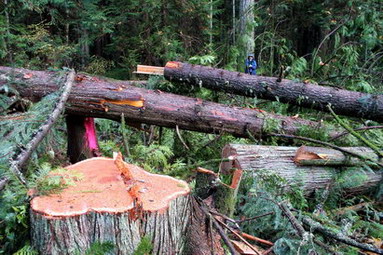
Ancient fir forest at Nanoose Bay.
Photo: Scott Tanner |
|
|
|
| |
|
|
|
|
| |
 |
|
| |
|
|
 |
|
| |
|
|
|
|
| |
|
|
|
|
| |

Pileated Woodpecker, Englishman River estuary, 2009.
Photo: Guy Monty
This level of habitat integrity is extremely rare due to the amount of industrial logging that has taken
place on private forest lands which dominate the region. Industrial logging
results in dark, dense monocultures stands of young trees with no proper
canopy, understory or structural diversity. DL33 should be preserved for
its outstanding habitat values" DL
33 Bird Survey. |
|
The destruction of rare old growth trees and their habitat is not acceptable in the new millenium. Birders who conducted a survey of the Nanoose Bay Forest (DL 33) saw a Pileated Woodpecker. "DL 33 is so rich in birds because as a largely mature forest, it contains the diversity of tree species and ages, with a well developed canopy and understory that provides all the ecological niches used by east Vancouver Island forest birds.

Ancient fir forest at Nanoose Bay.
Photo: Scott Tanner |
|
| |
|
|
|
|
| |
|
"DL33, one of the last remnants in the world
of a spectacular Coastal Douglas fir Forest ecosystem on the east coast of
Vancouver Island, is reduced to the number of a cutblock. This is a criminal
act as bad as the deliberate burning of the library in Alexandria or the
bombing of a great cathedral, because extinction is forever. What is lost
can never be rebuilt"
Right: Red legged frog in the Nanoose Bay Forest, 2010
An endangered species in an endangered habitat
|
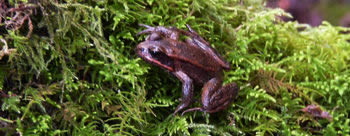 |
|
|
| |
 The BC government's facilitating of the forest destruction industry includes cynical setups whereby native communities are made responsible for the felling of the trees, not the corporations who are the real profiteers in this dirty business. Right: "What is at stake here is not the loss of some fine Douglas fir and cedar trees – it is the death of an ecosystem" Annette Tanner |
Left: On 1 January 2011, a tour of the Nanoose Bay Forest was conducted to protest against the granting of a logging permit. Crowds gathered to hear respected Qualicum First Nation leader Kim Recalma Clutesi, Oqwilowqwa, lecture on the importance of nature to indigenous traditions and way of life.
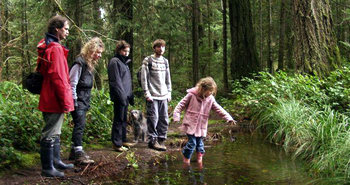 |
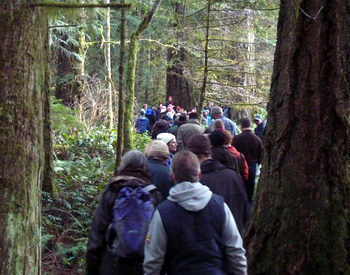 |
The wanton destruction of rare and valuable old growth trees and their habitat such as the Nanoose Bay Forest is not acceptable in the new millenium. The death of an ecosystem has a parallel in the death of indigenous traditions. Without the bounties of nature, there is no First Nations culture to celebrate. Ancient forests and big trees are a testimonial to the sustainable culture that existed here for millenia before colonization. To cut down the few grand old Douglas firs that have survived the ravages of settler society over the past century is to eliminate First Nations presence.
Especially repugnant is the partnership of the BC government with ruthless logging corps. Their propaganda cannot conceal evidence such as the massacre of the thousand year old Sitka spruce forest, known as the Pachena Grove, in 2006 by Island Timberlands (aka Weyerhaeuser and MacMillan Bloedel). Engineered by the government, the corp got away with its ecological crime by passing the buck to the local Indian band, a form of profiteering common to outlaw states. |
|
|
| |
|
|
| |
|
|
|
|
| |
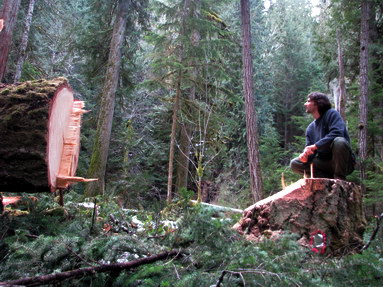
Destruction at Englishman River,
15 February 2009.
Photo: Fred Davis (PQB News)
In February 2009 Island Timberlands (aka Brookfield, Brascan, Weyerhaeuser, MacMillan Bloedel) was caught helicopter logging old growth Douglas fir trees along one of BC's most endangered rivers, adjacent to a park (above and right). Island Timberlands is the second largest private timberlands holding in BC, with 258,000 hectares. |
|

Englishman River, 12 February 2009.
Photo: Richard Boyce |
|
| |
|
|
 |
|
| |
See the report of 16 February 2009 (Parksville Qualicum Beach News):
Old Growth Logging Raises Anger. The "dollar value" trees being highgraded by Island Timberlands represent the most endangered Biogeoclimatic Zone in Canada: the Coastal Douglas Fir ecosystem (CDF) of which less than one percent is left. Friends of Cathedral Grove (FROG) Richard Boyce was dismayed to discover that among the downed trees was an old cedar photographed by him in 2004 when it was occupied by a bear, a habitat tree (right).
Island Timberlands has also been caught highgrading old growth trees within the contested 1300 hectare area that community activists have been fighting to protect as part of Cathedral Grove. This disregard of an internationally recognized nature monument and of the health of the community watershed is unacceptable. |
|
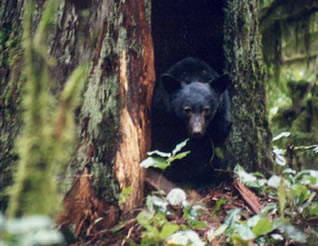
Bear in den, Englishman River, 2004.
Photo: Richard Boyce |
|
| |
|
|
|
|
| |
A precious remnant of an old growth Douglas fir forest is located along the Sooke River on Vancouver Island, British Columbia (BC). In 2005 the geological landmark known as the Sooke Potholes was included in a new regional park, thus saving at the last minute the popular public bathing site from commerical exploitation. The Sooke Potholes are part of the traditional territories and sacred heritage of the T'Sou'ke indigenous people for whom they are named.
Unbelievably, the rare and endangered ancient Douglas fir forest surrounding the potholes was not included in the park and has since been logged by TimberWest. Healthy Douglas fir trees equal in age to the 800 year old veterans of Cathedral Grove were cut down in a covert operation tied to real estate speculation by the sleazy logging company. |
|

Sacred Sooke Potholes.
T'Sou'ke First Nation Territory |
|
| |
|
|
|
|
| |

TimberWest logging the Sooke Potholes Forest,
2005.
Photos: Ingmar Lee (Click to enlarge)

Sooke River just before the potholes.
Vancouver Island, BC |
|
This wanton destruction wiped out the final tract of ancient fir forest in the Sooke River Valley, leaving a stumpfield and future development site. Ingmar Lee explains that he took the top photos in the collage about five years ago, when the ancient fir forest at the Sooke Potholes was still wild and pristine (left). The bottom photos were taken in May 2005, after TimberWest had begun its clearcut logging operation. They show that about half of the grand old Douglas firs are gone: "I was heart broken that this beautiful and exceedingly rare forest habitat was destroyed so secretly and so quickly to within ten metres of the most famous stretch of the potholes."

Old growth logs, 2006.
Sooke River
"Oftentimes on a summers morning, I head out to the Sooke Potholes, where I strip off all my clothes and swim naked into a most wondrous whelm of wilderness. Immersed in the crystal clear waters of the Sooke River, and looking up through the lofty boughs of the hoary old fir trees which cloak the valley, the sublimity of nature deeply permeates ones being. Drifting under the ancient trees one slowly sinks out of this world, and on through the realm of hamadryads and satyrs, and beyond.
All of the physical conditions for the human being's most ultimate quest are to be found here. No cathedral, no masjid, no mandir, vihara or synagogue can offer such immersion into that primaeval place from whence we have all evolved"
Tragedy and Travesty (Ingmar Lee). |
|
| |
|
|
|
|
| |
Ready to fight for Nanoose DL 33
Dear Gordon Campbell politicians,
We fought you and defeated you over your scheme to plow a giant motorhome parking lot into Cathedral Grove. That's a fight that ended chief parking lot proponent Gillian Trumper's political career, and which indelibly stained the reputation of your government. We fought the grotesque forest-destroying 'Bear Mountain' development that you all facilitated. We put Bear Mountain on the map as the worst example of stupid destructive development in the province. We will take some credit for the current bankruptcy of that hideous project, and for the imminent prosecution of its racist developer, your friend Len Barry.
Now, at Nanoose, we will fight you all again.
During the lengthy stint of your regime, none of you has done a damn thing to protect Canada's most endangered ecosystem, -the Coastal Douglas fir biogeoclimatic zone. Instead, you've facilitated voracious giant transnational logging giants like Weyerhaeuser, TimberWest and Island Timberlands to lay waste to virtually all of Vancouver Islands once magnificent primaeval fir forest. A succession of ecologically illiterate and ignorant politicians such as yourselves have overseen the destruction of a forest that once rivalled and even surpassed the stature of the California redwoods. It would have been easy for you to do the right thing and protect the tiny DL33 patch of CDF forest.
As the corporate media now begin to swarm around the DL33 issue, a key aspect of their framing strategy is to repeat the bogus Gordon Campbell government claim that "...there is more than 250,000 hectares of the Coastal Douglas-fir ecosystem left in B.C., but only 9% is on Crown land..."
This suggests to the corporate media readership that the CDF ecosystem, which comprises 20% of Vancouver Island, is in a stable, viable condition of health. This statement adds the even more preposterous implication that private interests had managed the CDF ecosystem more conservatively than their public counterparts. If there was a quarter million hectare tract of primaeval CDF ecosystem left anywhere in BC, we'd certainly be fighting to protect that, regardless of whether it be on private or public land. The fact is that the CDF ecosystem has now been virtually destroyed on your watch.
The central issue for DL33 is that conventional industrial logging, whether private or public, has utterly ransacked and destroyed more than 97% of the primaeval CDF ecosystem. Tiny postage-stamp patches of CDF like DL 33 are therefore priceless, irreplaceable refugia-tuft habitat oases, which store the final wilderness processes and DNA of one of the worlds most magnificent, and now virtually extinct ecosystems.
It is despicable that the Gordon Campbell government is using DL 33 to drive a wedge between a conscientious community that has worked carefully though the due process options
1

to protect that final little tuft of what was once this earth's most magnificent and endangered ecological splendors, and the Snaw-Naw-As First Nation, whose ancestral stewardship lasted over 10,000 years and brought the CDF forests to their epitomal efflorescence.
The environmental community understands and respects First Nations sovereignty over the lands, we want the lands returned even, and we expect that with careful, respectful work, a mutually agreeable solution can be found which protects the forest, and which is much more beneficial to the Snaw-Naw-As Nation than the pathetic fare and controversy that the Campbell government is offering.
It is unconscionable that you have used your precious time in office to forward the interests of giant corporate interests instead of making a useful contribution to humanity and the Earth's
most magnificent splendors. That you use your position in power to split and
divide our communities. The people of British Columbia have rejected Gordon Campbell's
corporate vision for BC. All the rest of you servile Campbellites should jump
off his sinking ship, and do something useful for the planet, -something that
you can be well remembered for by your grandchildren. Nobody ever goes down in
history for their efforts to increase the profits of corporations. Our fight
has never been with the Snaw-Naw-As First Nation. Our fight is with you. We are
ready to fight you, and beat you once again now, for DL 33
|
| <
|
|
| |
|
|
|
|
| |
|
|
|
|
| |
Cathedral Grove activist Ingmar Lee (right) protested at the Island Timberlands headquarters at Nanoose Bay in 2010. He condemns politicians for doing nothing to protect Canada's most endangered ecosystem, the Coastal Douglas fir (CDF) biogeoclimatic zone. Instead multinational logging corps continue to lay waste to what little is left of Vancouver Island's once magnificent primaeval fir forest. Lee makes the point that the central issue for DL33 is that conventional industrial logging, whether private or public, has utterly ransacked and destroyed more than 97% of the primaeval CDF ecosystem.
Tiny postage stamp patches of CDF like DL 33 are therefore priceless, irreplaceable refugia-tuft habitat oases, which store the final wilderness processes and DNA of one of the worlds most magnificent, and now virtually extinct ecosystems.
It is unconscionable that you have used your precious time in office to forward the interests of giant corporate interests instead of making a useful contribution to humanity and the Earth's most magnificent splendors.
2 January 2011
Ready to fight for Nanoose DL 33 |
|
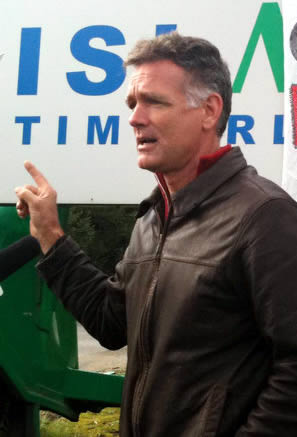 |
|
| |
|
|
|
|
| |
|
|
|
|
| |
|
|
 |
|
| |
|
|
| |
|
|
|
|
| |
Stop Killing Big Trees
The annihilation of rare and endangered big trees adjacent to Cathedral Grove in year 2000 by the American logging company Weyerhaeuser (successor of MacMillan Bloedel) was an ecological crime. To the premier of British Columbia (BC): "We turn to you with a Christmas appeal (right), which is that the BC government make the industrial logging of big trees illegal. These trees are symbolic of the magnificent nature of BC, just as the eagles, grizzlies, whales and salmon are. They belong to an ancient ecosystem with a rich biodiversity and it is our duty to preserve such trees and their forest habitats for future generations. Moreover, big trees are an integral part of the cultural heritage of the First Nations and they were sustainably managed long before the colonization of the Pacific Northwest. . . " |
|

Christmas Appeal. (Click to enlarge)
Stop Killing Big Trees |
|
| |
|
|
 |
|
| |
 |
|

 |
|
| |
|
|
 |
|
| |
|
|
| |
|
|
|
|
| |
MacMillan Park Stumpfield
Scores of visitors from all over the world come to see Cathedral Grove, a rare surviving stand of big trees on Vancouver Island. Not long ago this tiny 157 hectare park was part of a magnificent and ancient rainforest ecosystem containing many thousand year old trees. Most of this ecosystem was plundered by H. R. MacMillan, the first provincial appointed forester in BC and one of its most powerful timber barons. In 1944, with great reluctance, this notorious "Emperor of Wood" donated Cathedral Grove to BC and it became "MacMillan Park." On 5 January 2005 forest activists found a survey crew in the woods and took a photo of their base map (right). Not until months later was the secretly negotiated deal to expand the beleaguered park with a stump field announced with great hoopla. |
|

MacMillan Park Addition, 5 January 2005.
Photo: Richard Boyce |
|
| |
|
|
 |
|
| |

Old growth logging next to Cathedral Grove, 2001.
Photo: Richard Boyce
The Friends of Cathedral Grove (FROG) rejected the miserly stump field donation by the logging company and called for the some 400 hectares of standing ancient forest in the Cameron Valley directly adjacent to Cathedral Grove to be expropriated from Weyerhaeuser. FROG proposes that this land be returned to the First Nations whose historic stewardship and usage is everywhere evident: "Backroom land deals between government and Weyerhaeuser will continue to leave First Nations and the general public without a voice" 5 January 2005:
FROG Press Release.
"Here's Weyerhaeuser once again trying to flog off a logged out stump field to the people of BC for millions of dollars. The land is now useless to Weyerhaeuser and is nothing but a tax burden to them." FROG warned the BC government that the MacMillan Stump Field Addition did not mitigate the negative impacts of its misguided plan to construct a large parking lot on the floodplain of Cameron River, upwind of the already stressed big trees in Cathedral Grove. |
|
The "MacMillan Park Addition" was a cutblock withdrawn from Weyerhaeuser's private timber tenure which surrounds Cathedral Grove (left). The 140 acre "donation" was added to the 21 hectare stump field which the BC government bought from Weyerhaeuser in 1999 for $1.7 million. Notably both backroom deals excluded the commercially valuable old growth forest remnants that provide a vital buffer for Cathedral Grove.
"New addition to MacMillan Park,"
Nature Trust map showing stumpfield |
|
| |
|
|
|
|
| |
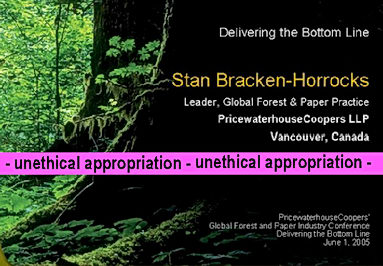
Ancient trees used as forest industry propaganda.
Pricewaterhouse Coopers, Vancouver BC, 2005 |
|
Delivering the Bottom Line: the Extermination of Ancient Trees for Commercial Greed. The forest industry's pittance to Cathedral Grove (above) was greenwashed by Nature Trust chairman, Peter Speer, a former partner of Pricewaterhouse Coopers. This advertising corp for the forest and paper industry organized the Global Forest and Paper Summit in Vancouver in 2005. In an act of vile unethical appropriation, it used an image of big trees in an iconic "Cathedral Grove" to promote the Summit (left). The purpose of the Summit was to celebrate the doubling of worldwide profits in the forest and paper industry in 2004, led by BC's profit of $1.5 billion. An appalling annual glorification of rampage and deforestation, the Summit was attended by over 700 world leaders from the forestry, pulp, paper, wood products and packaging trade sectors. |
|
| |
|
|
 |
|
| |
|
|
| |
Mount Arrowsmith Biosphere
1856— Mt. Arrowsmith is named after British cartographers Aaron and John Arrowsmith by Capt. Richards of the Royal Navy who surveys and charts Vancouver Island.
— Cameron Lake and Cameron River are named after Scottish miner David Cameron, chief justice and first judge of the new British colony of Vancouver Island. The mouth of Cameron River at Cameron Lake is the site of the ancient tree stand, Cathedral Grove
— Scottish fur trader and settler Adam Horne "discovers" an ancient indigenous trading trail
from Qualicum on the eastern side of Vancouver Island across the Beaufort Range into Alberni Valley which is later used by settlers. Horne Lake, in the next valley north of Cathedral Grove, is named after him. |
|
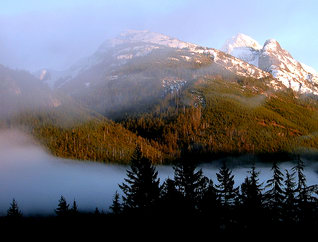
Mount Arrowsmith, Vancouver Island
British Columbia, Canada |
|
| |
|
|
|
|
| |

Cameron Lake, Vancouver Island
British Columbia, Canada |
|
I have lived on this lake on Vancouver Island for 25 years, and driven it many, many times. There is a certain time of day in the fall where on a sunny day the view of this spit is amazing. For years I have wanted to capture it on film, uh pixels. So finally last year I drove out in the late afternoon for the specifi purpose of taking pictures of it. The patch of trees on the end of the spit reminds me of that island in Normandy with a castle or abbey on it.
their names also serve as figleafs to cover the shame of those who cut the big trees down
MacMillan Bloedel = Weyerhaeuser = Brascan = Unethical Logging by Island Timberlands = Brookfield = NYSE: BAM = TSX: BAM.A = BAMA. EU
| |
| |
|
|
|
|
| |
Chameleon Logging Corporations
Wreaking Havoc on Vancouver Island
Island Timberlands
MacMillan (1923 to 1939) - MacMillan Bloedel (1939 to 1999) - Weyerhaeuser (1999 to 2004) - Brascan (2004 to 2005) - Cascadia - Island Timberlands - Brookfield (2005-2011)
|
mmmm
mmmm
mmmmmm
mmm
mmmm
the financial imperative of returning maximum profits to corporate shareholders.
Our planet cannot afford to lose any more ecological value as a sacrifice to corporate profits or even national economic benefits. Historically, our propensity has been to favour material progress over environmental precaution. This irrational optimism is leading to catastrophic consequences.
Ben Parfitt : Restoring the Public Good on Private Forestlands
|
|
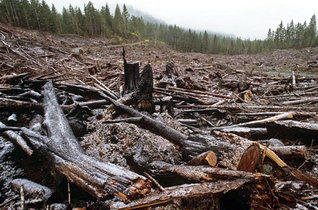
Island Timberlands clearcut, December 2007.
Vancouver Island, British Columbia, Canada
Association of Vancouver Island and Coastal Communities (AVICC) Every coastal community is alarmed at the potential for the transition of current
private managed forest lands to real estate development – a huge structural
aspect of forest ‘redevelopment’ that has been completely overlooked by this
report. Should this occur, massive tracts – in the tens of thousands of hectares -
would be lost to productive forestry. In fact, it is the stated intentions of two of
the major private land holders on the Island and on the lower coast of the
province - Island Timberlands and TimberWest (TW) Forest Corporation - to
move away from ‘traditional’ forestry towards a theoretical “highest and best”
designation of their lands. Both companies have evolved corporate facades and
TW has created an actual real estate arm; in the case of Island Timberlands –
Bermuda based Brookfield Asset Management - and TimberWest, the largest
private land owner in western Canada, has created Couverdon.
While local governments have, by and large (and ostensibly with the support of
the courts), the zoning tools to protect these lands as forest lands, apprehension
exists that the provincial government could overrule local government land use
regulations and invoke legislation similar to Bill 30 and/or Bill 75. To assist local
governments, an opportunity exists with the provincial government to re-establish
the forest land use designation to provide certainty, or put forest lands into the
Agricultural Land Reserve (ALR).
Private Forest Lands (PFLs) taxation is also at a disadvantage when compared
to properties in the ALR. PFLs are hit with a tax when the timber is harvested; a
farmer who harvests timber on his/her property is not. This playing field should
be levelled.
The continuing practice of log exports – particularly from private managed forest
lands – remains problematic for those communities who continue to seek lost
appertency benefits – not necessarily as was formerly, and formally, tied to forest
tenures such as TLs or TFLs - but rather via simple forest worker employment
that could be created by engaging local workers and contractors to conduct the
complete harvesting cycle – from cruising to regeneration. By importing “stump
to dump” contractors that may come from any place in the province (or under
TILMA - out of province) - generally at the lowest cost possible - forest
companies may well be maximising their attempts at generating profits at the
expense of the general well being of the communities we all serve and in which
they operate. This could result in a traditional “race to the bottom” campaign with
all parties ultimately failing. In addition, the removal of the fibre from the
provincial supply chain through export – particularly to the U.S. – creates an
unfair trade advantage for the U.S. lumber industry and a complete loss of the
fibre for our own pulp and paper sector, already in desperate financial chaos. |
|
| |
|
|
|
|
| |
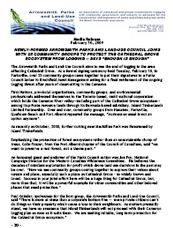 |
Arrowsmith Parks and Land Use Council was founded in October 2008 when logging threatened Cathedral Grove. Its primary goal is the protection of the Cameron River Valley and the Cathedral Grove Ecosystem. Members intend to cast a caretaker’s eye over other protected areas as well. The Council is committed to engaging with community, government and industry to advocate for the conservation and expansion of parks and protected areas within the Mt Arrowsmith watersheds. |
|
|
|
|
| |
|
|
 |
|
| |
|
Arrowsmith Parks and Land Use Council aims to bring industrial logging in the Cathedral Grove Valley to an end
Right: On 10 February 2009 over 25 community groups signed a letter to the Brookfield corp. They demanded the corp stop destroying the endangered Douglas fir ecosystem that nurtures Cathedral Grove |
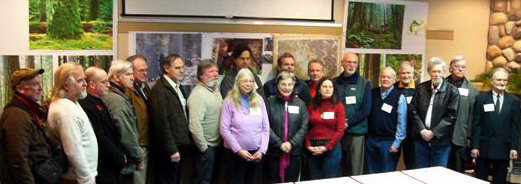 |
|
|
| |
|
|
|
|
| |
 |
Corporate Doubletalk: "I can assure you that we have no near term harvesting plans to our lands adjacent to MacMillan Park"
Left: Letter dated 26 March 2009
from Darshan Sihotta, Island Timberlands (Brookfield Corp) to
Arrowsmith Parks and Land Use Council.
|
|
|
|
|
| |
|
|
 |
|
| |
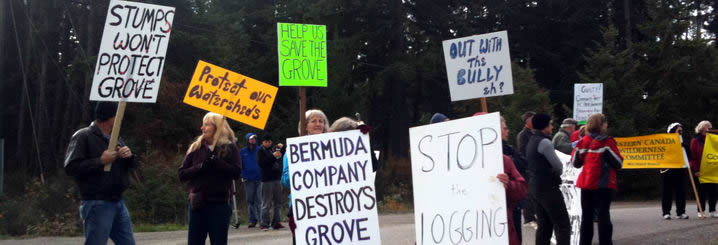
Community Protest Against Island Timberlands at Cathedral Grove, 7 October 2008. |
|
|
| |
|
|
|
|
| |
|
|
|
|
| |
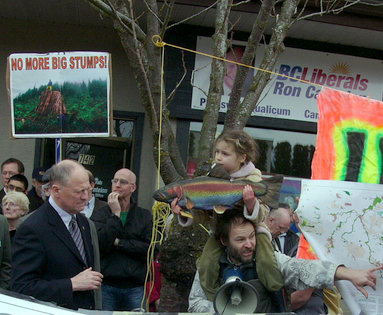
Protest against Island Timberlands, 28 February 2009.
Photo: Phil Carson |
|
Mount Arrowsmith Biosphere In 2009 a coalition of citizens drawn from various social justice and environmental groups in the Arrowsmith region was formed as a watchdog: Arrowsmith Parks and Land Use Council. The group helped to organize a protest outside the office of the BC Minister of Lands and Agriculture on 28 February 2009 (left). Community members say the logging by Island Timberlands at Cathedral Grove and Englishman River is evidence of all that is wrong with forestry policies whereby watersheds and riparian areas are given no protection or proper stewardship.
In contrast, the rights of the timber corporations were legislated with the 2004 Private Managed Forest Land Act that has resulted in further ecological and economic disasters for local communities. This Act enabled the corporations to engineer the selloff of their forestlands into hugely profitable real estate holdings. |
|
| |
|
|
 |
|
| |
Habitat Encroachment Many of local citizens outraged by the nature desecration in their communities are also defending Cathedral Grove from the incursions of irresponsible logging. "How desperate is Island Timberlands that they invaded a tiny river island, adjacent to a provincial park, in the heart of the Englishman River watershed, to extract some 20 veteran old growth trees? Until now, these 300 to 400 year old trees growing in this complex and fragile island ecosystem, were respected and bypassed by generations of previous logging operations. Where will Island Timberlands log next to satisfy this greedy, despicable addiction for old growth timber?" Scott Tanner:
Old Growth Logging Raises Anger.
Scott Tanner and Phil Carson appear in a video documentary by Richard Boyce " Heli Logging Island in Englishman River." "Island Timberlands is Brascan – a big Canadian company that has gone offshore and is down in the Bahamas to escape taxes and environmental regulations. They are absolutely decimating our ecosystem, our drinking water, the habitat for our fish. They would never get away with this in other parts of the world. In Washington State you couldn't log within 200 feet of a river, but here they are right in the middle of Englishman River on an island taking the last little patches of old growth . . . and thumbing their noses at the rest of us. It's got to stop" Phil Carson.
The contentious issue was raised during Legislature on 24 February 2009: "Island Timberlands has been logging old growth right in the middle of the Englishman River. . . a key water source for the city of Parksville and the entire region. . . the Parksville city council passed a unanimous resolution urging this government to step in,
intervene and halt this logging" Scott Fraser, MLA for Alberni Qualicum. |
|
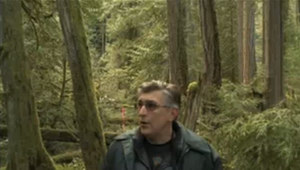 |
Scott Tanner of Qualicum Beach |
 |
Phil Carson of Coombs |
 |
Scott Fraser of Port Alberni |
|
|
| |
|
|
|
|
| |
|
|
|
|
| |
Protest Against Island Timberlands at Nanoose, 27 October 2009
Unethical Logging by Island Timberlands = Brookfield = NYSE: BAM = TSX: BAM.A = BAMA. EU |
|
|
| |
|
|
 |
|
| |
Unethical Logging by Island Timberlands = Brookfield = NYSE: BAM = TSX: BAM.A = BAMA. EU |
|
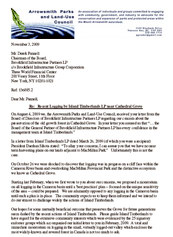 |
 |
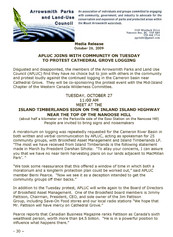 |
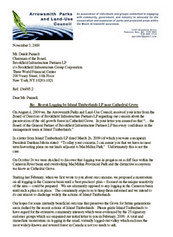 |
|
Preservation of
Cathedral Grove
10 February 2009 |
New Logging Near
Cathedral Grove
24 October 2009 |
Community Protest Against
Cathedral Grove Logging
26 October 2009 |
Condemnation of Logging
by Island Timberlands
3 November 2009 |
|
|
| |
|
|
|
|
| |
|
|
| |
|
|
|
|
| |
"Viva Touristika" Rostock
As the "No. 2" foreign destination for German tourists, Canada was the focus of a special section of the 2005 Rostock Tourism Exposition, called "Viva Touristika." About 13,000 visitors were introduced to Canada's official tourism advertising campaign: "Canada: Discover Our True Nature." But the exposition organizers also wanted to give an alternative and non-commercial view of Canada, so they invited two German environmental groups to participate: ArbeitsKreis noerdliche Urwaelder (AKU), or the Network for the Preservation of Northern Primaeval Forests; and its partner organization "Urgewald." The environmentalists presented a "behind the scenes" view of nature destruction in British Columbia (BC) in a poster gallery of pictures and text supplemented by lectures and interviews (right). |
|

Interview with Lydia Bartz of urgewald
Photo: Karen Wonders |
|
| |
|
|
 |
|
| |
 German environmental activists, Rostock, 2005.
Photo: Karen Wonders |
|
AKU and Urgewald Right: AKU activists (from left: Imke Oncken, Lydia Bartz, Christian Offer, Stephan Roehl, Jutta Beher). They informed people that the wild nature scenery promoted by the tourism industry in BC hides the grim reality of the international wood products industry. Press commentary on the event pointed to the need for a "sanften Tourismus," a new form of sustainable tourism based on indigenous cooperation.
One of the posters presented by AKU at Rostock condemned the killing of grizzly bears in BC for trophies and sport by German tourist hunters. Although the European Union banned the import from Canada of grizzly trophies in 2006, Germans remain second only to American big game hunters as the most enthusiastic killers of these bears and they represent an influential lobby group. |
|
| |
|
|
|
|
| |
"Kahlschlag für Deutschland"
German Poster Display by AKU (Click images to enlarge)
On the Destruction of Rainforests and Indigenous Culture in British Columbia,
Canada |
 |
 |
 |
 |
 |
Poster 1 |
Poster 2 |
Poster 3 |
Poster 4 |
Poster 5 |
|
|
|
|
|
 |
 |
 |
 |
 |
Poster 6 |
Poster 7 |
Poster 8 |
Poster 9 |
Poster 10 |
|
|
| |
|
|
 |
|
| |
|
|
| |
|
|
|
|
| |
Koksilah Big Tree Grove
A surviving old growth remnant with big trees, located near the headwaters of the Koksilah River, is endangered. The small grove of ancient Douglas firs (right) is part of the Shawnigan Division tree farm licence owned by MacMillan Bloedel until 1999 when it was sold to Weyerhaeuser. In 2004 it was sold again, this time to TimberWest. During the past few decades, the forest here has been extensively clearcut logged. Unique trees that were felled included the largest and tallest Douglas firs in the recorded history of BC. The renowned Koksilah Fir was 1340 years old when she fell in 1986, blown down after the removal of the surrounding protective forest. It is shocking that the small ancient Douglas fir grove that remains continues to be at risk by the failure to enact old growth forest protection legislation. |
|

Big tree threatened by TimberWest, 2006
Photo: Warrick Whitehead |
|
| |
|
|
 |
|
| |

Indigenous canoes on Koksilah River," c. 1900.
Photo: BC Archives
Rare and magnificent ancient big trees in the Koksilah River Forest are marked for logging by TimberWest. The forest heritage of this area belongs to the Cowichan Tribes. The river is is named for the Koksilah people who came from the village of "xwélkw'sáleon" (above). They also had a seasonal fishing village called "xtémten" on the upper Koksilah River, at Marble Falls. Until the late 19th century when European settlers invaded and alienated the land, the Cowichan Valley had a numerous indigenous population. |
|

Koksilah River from Burnt Bridge.
Cowichan Valley, Vancouver Island |
|
| |
|
|
 |
|
| |

Ancient Douglas fir grove, Koksilah River Forest.
Photo: Warrick Whitehead
The Douglas firs in the Koksilah grove of big trees represent an ecosystem that has been virtually exterminated by logging. The Western Canada Wilderness Committee launched an education initiative which is part of a larger campaign aimed at shaking up the BC government to take action on protecting Vancouver Island's ancient trees and forests. Despite the precious biodiversity of the Koksilah River Forest, TimberWest plans to save only four acres of the biggest trees and to cut down the protective fringe forest. This logging company's strategy to "cut all around it and watch it blow down" has already proved disasterous at Cathedral Grove. Wilderness Committee campaigner Ken Wu reminded the timber company: "Creating a little postage stamp in the middle of a clearcut doesn't save the living ecosystem." The endangered forest is furthermore of great value to the local community as a tourist attraction. Although in 1989 a highly publicized fight to save the Koksilah big trees forced the forest industry to stop logging, old growth timber prices are high and the danger to the trees remains, many of which are marked for logging (right). |
|
The Koksilah River Forest was included in the 1883 land grab by the Scottish coal baron – settler, Robert Dunsmuir, that robbed First Nations of about one quarter of their lands on Vancouver Island. As a result, vast forests ended up under the control of railway and logging companies which claim that these regions are "private land," subject to no environmental laws. TimberWest has already logged off most of the lucrative old growth on Vancouver Island and is now selling its forest holdings to real estate developers.

TimberWest marked tree, Koksilah.
Photo: Warrick Whitehead |
|
| |
|
|
 |
|
| |

Kinsol Bridge, Koksilah River, 2007.
Vancouver Island, BC |
|

Kinsol Bridge, Koksilah River, 2007.
Vancouver Island, BC |
|
| |
|
|
|
|
| |

"Across the Abyss." Painting by Paul Grignon.
Save the Kinsol Trestle
The trestle was abandoned in the 1980s and the structure has slowly deteriorated. The government is threatening to dismantle it, but a protection campaign was launched to save the Kinsole Trestle. The painting above is based on a photo of Niagara Trestle (right), further south on the railway track, close to Goldstream Park and Victoria. Like most old wooden railway trestles in BC, it has long been destroyed. These massive industrial relics are a reminder of how bountiful the ancient BC forests must have been. |
|
The Kinsol Trestle is an important part of the Koksilah River Forest Heritage (above left and right). Completed in 1920, this 187 meter curved railway trestle over the Koksilah River is one of the world's highest. Its primary function was to facilitate the logging industry's deforestation of Cowichan Valley, once home to some of the largest trees on the North American continent. Constucted from massive cedar beams, the railway trestle is the dead reminder of what used to be a living primaeval forest.

Niagara Trestle, Goldstream Park, c. 1900.
Photo: BC Archives |
|
| |
|
|
 |
|
| |
|
|
| |
|
|
|
|
| |
"Kahlschlag in Kanada"
On 2 December 2004 in Goettingen, Germany, a lecture was held by Philipp Kuechler about the impact of the global wood products industry on Canadian forests (right). He especially focussed on the clearcutting of the temperate rainforests of British Columbia (BC). The lecture was held in conjunction with the opening of a travelling exhibit on paper consumption; "Papierwende." Introducing the lecture was Stefan Wenzel, the leader of the German Green Party for Lower Saxony. The Faculty of Forest Sciences at Goettingen University is one of the world's first and is well known for its research on silviculture. One forestry professor who attended the lecture expressed his shock at the sort of outdated clearcutting practices that continue to dominate the forest industry in BC and wreck environmental havoc. |
|

Philipp Kuechler, Goettingen, 2004
Photo: Karen Wonders |
|
| |
|
|
 |
|
| |

Colleen McCrory and Stefan Wenzel, Hanover, 2004.
Photo: Karen Wonders
On 4 April 2003 the German environmental activist groups Urgewald, RobinWood and AKU held a symbolic clearcutting, "Kahlschlag in Kanada fuer deutsches Papier" (right) at the Bonn headquarters of the German Pulp and Paper Assoc. to protest against its importing of high grade magazine pulp from endangered ancient cedars in BC and to show support for protecting the Great Bear Rainforest. The activists also accused the German paper industry of being accomplice to the robbing of Indian land:
Symbolischer Kahlschlag. |
|
In May 2004 Stefan Wenzel invited his Canadian colleague, Colleen McCrory, then deputy leader of the Green Party of BC, to Hanover to attend a session of Parliament (left). The German Green party leader wrote a letter on 16 August 2004 to express his grave and carefully considered concern over deforestation in BC to the Speaker of the BC Legislative Assembly:
Wenzel to Richmond. No reply was received, not surprising given the economic collusion between the government of BC and the global wood products industry.

German Pulp and Paper protest, Bonn, 2003.
Photo: Stephan Roehl |
|
| |
|
|
 |
|
| |
 |
|
Beginning in 1993, when German groups held a protest in solidarity with the forest activists arrested at Clayoquot, the clearcutting of the ancient Northwest Coast forests has led to a worldwide rallying call for action to stop this senseless destruction. Also in 1997 a protest was held at the Canadian Embassy in Bonn during which about 30 environmentalists joined Nuxalk indigenous activists to protest against Canada's continued human rights violations. They called for the cessation of industrial exploitation of natural resources on unceded Indian land. Nuxalk House of Smayusta Chief Qwatsinas took part as well as Colleen McCrory of Valhalla Wilderness Society. See the information brochure (left):
Kanada. |
|
| |
|
|
 |
|
| |
|
|
| |
|
|
|
|
| |
Save the Klaskish Giant and East Creek
The Klaskish Giant (right) is a record sized ancient cedar tree located in Quatsino First Nation Territory on the northwest coast of Vancouver Island in British Columbia (BC). The magnificent tree grows in the remote East Creek Watershed which drains into the Klaskish Inlet. Until the late 1990s both the East Creek and Klaskish watersheds were pristine roadless wildernesses, classified as Crown (publicly owned) forestland. In the late 1990s International Forest Products (Interfor) began blasting a logging road into the Klaskish and within five years it had gutted the valley. Weyerhaeuser was next to assault East Creek, blasting a logging road into the pristine valley in 2003. Clearcut logging devastation continues today by Western Forest Products, spelling doomsday for ancient trees like the Klaskish Giant (right). |
|

Klaskish Giant, East Creek, 2003.
Photo: Ingmar Lee |
|
| |
|
|
 |
|
| |

Location of the Klaskish Giant.
Quatsino First Nation Territory
The "Place of Origin" for the Quatsino people is Xwatis (Hwates) in Quatsino Sound. Xwatis was known for its monumental houses and totem poles. Quatsino artist George Nelson carved a housepost (right) from an ancient red cedar tree for the "Sea Lion House" in 1906. Several years later Edward Curtis photographed the ancestral figure with a whale on its chest and coppers on its arms for his epic publication on North American Indians.
Quatsino By 1955, this single housepost was all that remained of the Sea Lion House at Xwatis. Today it is displayed in the University of British Columbia's Museum of Anthropology. Not much remains of Quatsino culture and traditional village sites, in large part due to the forced amalgamation of the tribes to make way for settlers and in 1972 the forced relocation of the inhabitants of Xwatis. |
|
The Klaskish Giant survives only because of her remote and roadless location on Klaskish Inlet, seen on the map inset (left). Klaskish Inlet was originally inhabited by the Klaskino people, one of five Kwakwaka'wakw tribes (Giopino, Hoyalas, Klaskino, Koskimo and Quatsino) which are today represented by the Quatsino First Nation.

Housepost, Xwatis, 1955.
Photo: BC Archives (W. Duff) |
|
| |
|
|
 |
|
| |

East Creek and Klaskish Inlet, Vancouver Island, 2003.
Photo: Sierra Club BC
The destruction of the Quatsino forests on Klaskish Inlet is continuing as a new logging road is being blasted into the pristine lower East Creek. See two eyewitness accounts and photo galleries: by Western Canada Wilderness Committee director Joe Foy: East Creek – 2003 (right); and a follow up report by Richard Boyce: East Creek – 2008 (far right). |
|
The beautiful and extremely rare intact forests of East Creek at Klaskish Inlet were photographed from the air in 2003 (left). Ominously, in 2003 the Lemare Lake Logging company was contracted by the forest products corporations to construct a logging road into the valley, destroying 1000 year old yellow cedars in the process (below).
|
Crimes Against Ancient Forests |
Click photos above for Galleries |
|
|
| |
|
|
|
|
| |

Ingmar Lee, Klaskish Inlet, 2004.
Photo: Krista Roessingh
Filmmaker, forest activist and tree climber Richard Boyce often works in the canopies of big trees. In 2008 he travelled to Klaskish Inlet where he witnessed a shocking display of old growth destruction (right). He notes: "The East Creek Rainforest is home to all five species of spawning salmon (chinook, coho, sockeye, chum, and pinks), Roosevelt elk, many nesting marbled murrelet sea birds, black bears, cougars, wolves, deer, giant red cedar and sitka spruce bottom lands, and a spectacular estuary." |
|
Beyond the Cutting Edge While kayaking in Klaskino Inlet in 2004, forest activist Ingmar Lee filmed the endangered wilderness landscape and Quatsino homeland for a documentary video (left). "It is truly heartbreaking," says Lee, "to see these enormous log trucks loaded with ancient yellow cedar from the highlands of the East Creek Valley"
Momentous Primeval Moments.

Richard Boyce, East Creek, 2008.
Photo: Ryan Murphy |
|
| |
|
|
 |
|
| |

Increment boring, East Creek - Klaskish Inlet, 2004.
Photo: Krista Roessingh
By determining the spatial and chronological extent of past forest use by precise measurements, the ancient Klaskish forest was shown to have been sustainably harvested for bark, planks and resin. Seven areas were surveyed using judgemental sampling techniques, and culturally modified trees (CMTs) were found in all areas. A total of 55 probable and definite CMTs were recorded, and many others were observed but not recorded. Modifications were recorded on Western hemlock, Western red cedar, yellow cedar, and Sitka spruce trees. CMT types include taper strip, rectangular bark strip, and plank strip scarred trees, plank strip scarred logs, flattop and barber chair stumps, and resin holed trees. Hoping to save remarkable and irreplaceable trees such as the Klaskish Giant (right), the researchers sampled the CMTs and applied dendroarchaeological techniques to estimate the age of modifications. The earliest estimated date of modification was 1739, and one third of the samples apparently dated from the years between 1820 and 1860. |
|
To bring attention to the endangered trees of East Creek and the urgent need to protect the irreplaceable aboriginal heritage of Klaskish Inlet, a dendroarchaeological survey was conducted in 2004 by University of Victoria students Krista Roessingh and Ingmar Lee with the permission of Quatsino Chief Tom Nelson. Increment boring was used to date scar tissue from the trees (left).

Klaskish Giant, 2004.
Photo: Ingmar Lee |
|
| |
|
|
|
|
| |
|
|
|
|
| |
|
|
 |
|
| |
 mmm mmm |
|
| |
|
|
|
|
| |
|
|
|
|
| |
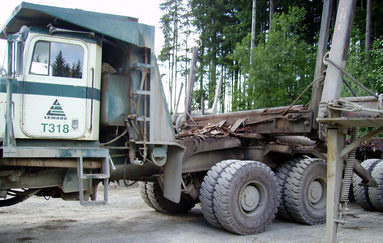
mmmmmmmmm
mmmmmmmmm |
|
|
|
| |
|
|
 |
|
| |

Ancient forest destruction in the Klakish and East Creek Watersheds at Klaskish Inlet,
Vancouver Island, BC, 2003.
Photo: Joe Foy, Western Canada Wilderness Committee |
|
| |
|
|
 |
|
| |
|
|
| |
©
Credits & Contact |
|
| |
|
|
|
|

